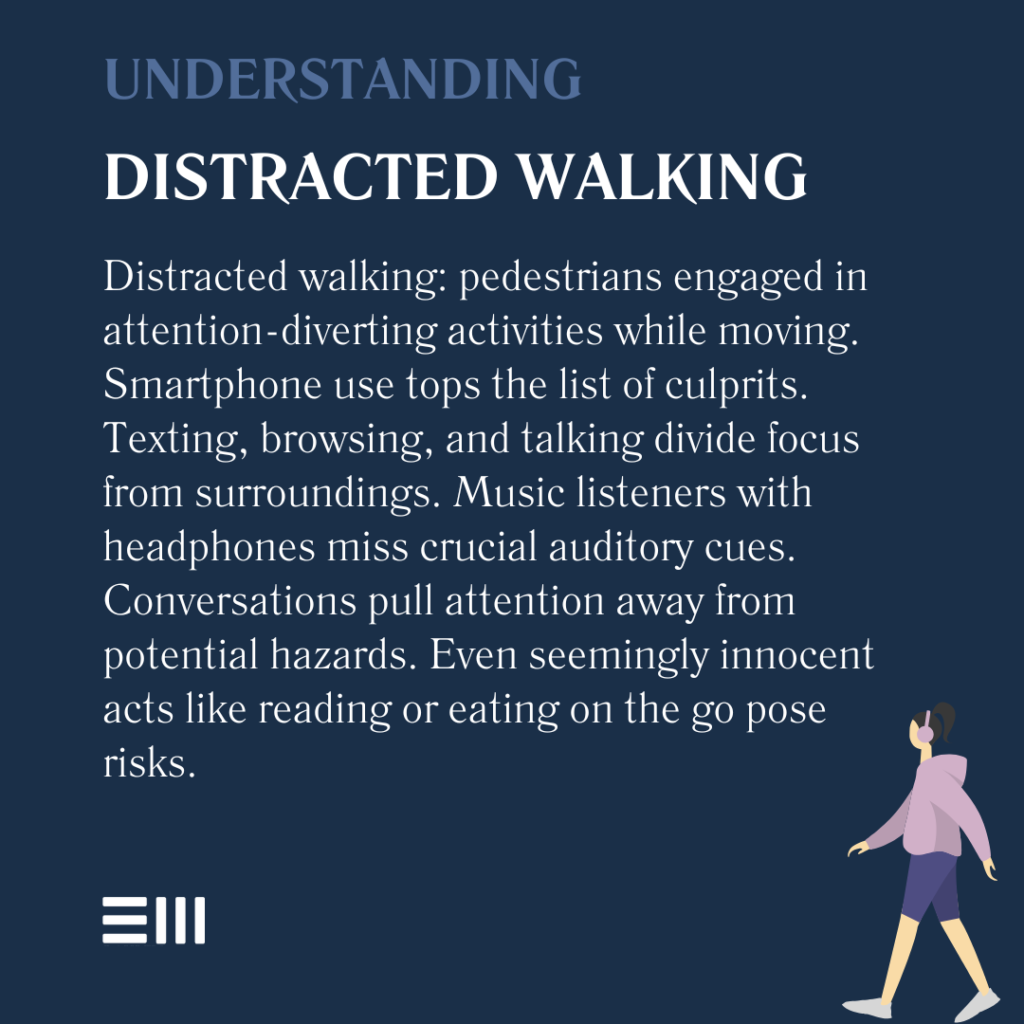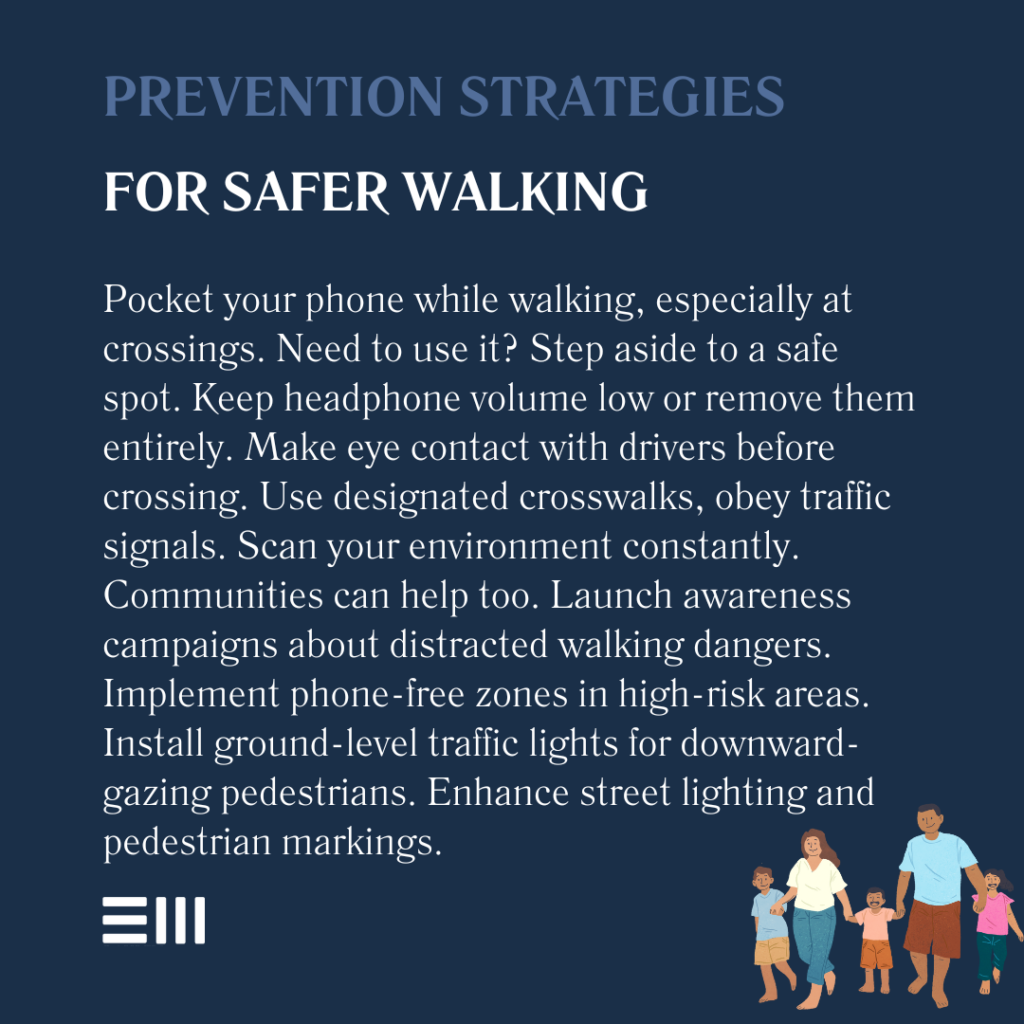
In 2019, over 6,000 pedestrians lost their lives in traffic accidents across the United States, with distracted walking playing a significant role.
As smartphones become ubiquitous, the dangers of navigating streets while engrossed in screens have skyrocketed.
This alarming trend has sparked concern among safety experts and legal professionals alike, prompting a closer look at the risks and responsibilities associated with distracted walking.
Understanding Distracted Walking
Distracted walking occurs when pedestrians engage in activities that divert their attention from the task of safely navigating their surroundings.
This phenomenon has become increasingly prevalent in our technology-driven world, posing significant risks to both pedestrians and motorists.
Common distractions for pedestrians include:
- Using smartphones (texting, browsing, or talking);
- Listening to music or podcasts with headphones;
- Engaging in conversations with others;
- Reading books or documents while walking; and
- Eating or drinking on the go.
As our reliance on mobile devices grows, so does the potential for dangerous distractions while walking.
Understanding these distractions is the first step in addressing the issue and promoting safer pedestrian behaviors.

The Dangers of Distracted Walking
The consequences of distracted walking can be severe, ranging from minor injuries to fatal accidents.
Some of the most common types of distracted walking accidents include:
- Collisions with vehicles;
- Trips and falls on uneven surfaces;
- Walking into stationary objects;
- Falling down stairs or off curbs; and
- Bumping into other pedestrians.
These accidents can result in various injuries, such as:
- Sprains and fractures;
- Head trauma and concussions;
- Cuts and bruises;
- Spinal cord injuries; and
- In severe cases, fatalities.
Real-life incidents highlight the gravity of this issue.
Such cases underscore the importance of remaining vigilant and aware of one’s surroundings while walking.
Legal Implications of Distracted Walking
Understanding the legal aspects of distracted walking is crucial for both pedestrians and drivers involved in accidents.
In Alabama, as in many states, the legal landscape surrounding these incidents can be complex.
Liability issues:
- Pedestrian responsibility: Distracted walkers may be held partially or fully liable for accidents they cause or contribute to.
- Driver responsibility: Motorists have a duty of care to watch for pedestrians, even if those pedestrians are distracted.
- Property owner liability: In some cases, property owners may be held responsible if unsafe conditions contributed to a distracted walking accident.
Comparative negligence in Alabama:
Alabama follows the contributory negligence rule, which is particularly strict. Under this rule, if a pedestrian is found to be even 1% at fault for an accident, they may be barred from recovering any damages.
This makes it especially important for distracted walking victims to consult with an experienced attorney who can help navigate these complex legal waters.
Understanding these legal implications can help both pedestrians and drivers make informed decisions about their actions and potential consequences.
Prevention Strategies
Preventing distracted walking accidents requires a combination of individual responsibility and community-wide efforts.
We can significantly reduce the risks associated with this dangerous behavior by implementing effective strategies.
Tips for staying safe while walking:
- Put away your phone or device while walking, especially when crossing streets;
- If you must use your phone, stop and step to the side in a safe area;
- Remove headphones or keep the volume low enough to hear surrounding noises;
- Make eye contact with drivers before crossing streets;
- Use designated crosswalks and obey traffic signals; and
- Stay alert and scan your environment regularly.
Community and governmental initiatives:
- Public awareness campaigns highlighting the dangers of distracted walking;
- Implementation of “phone-free zones” in high-risk areas;
- Installation of ground-level traffic lights for pedestrians looking down at devices;
- Enhanced street lighting and clearer pedestrian markings; and
- Educational programs in schools and workplaces.
By adopting these prevention strategies on both personal and community levels, we can create safer environments for pedestrians and reduce the incidence of distracted walking accidents.

Steps to Take After a Distracted Walking Accident
If you find yourself involved in a distracted walking accident, taking the right steps immediately afterward can be crucial for your health and any potential legal claims.
Immediate actions:
- Seek medical attention, even if injuries seem minor;
- Call the police to file an official report;
- Gather contact information from witnesses;
- Take photos of the accident scene, including any hazards or contributing factors; and
- Avoid admitting fault or making statements about the accident to anyone except the police.
Documenting the incident:
- Keep a detailed record of all medical treatments and expenses;
- Save any damaged personal items as evidence;
- Write down your recollection of the event as soon as possible;
- Obtain a copy of the police report; and
- Keep a journal of how the injuries affect your daily life.
Taking these steps can help protect your rights and provide valuable evidence if you need to pursue legal action or an insurance claim.
Frequently Asked Questions
Understanding distracted walking accidents and their legal implications can be complex.
Here are answers to some commonly asked questions to help clarify key points.
What Is Considered Distracted Walking?
Distracted walking occurs when a pedestrian engages in activities that divert their attention from safely navigating their environment.
This typically involves using electronic devices but can also include eating, reading, or intensely conversing while walking.
Can I Be Held Liable for an Accident if I Was Distracted While Walking?
Yes, it’s possible to be held liable for an accident if your distracted walking contributed to the incident.
In Alabama, due to the contributory negligence rule, even a small percentage of fault could significantly impact your ability to recover damages.
How Long Do I Have to File a Claim After a Distracted Walking Accident in Alabama?
In Alabama, the statute of limitations for personal injury claims is generally two years from the date of the accident.
However, it’s advisable to consult with an attorney as soon as possible to ensure your rights are protected.
What if Both the Driver and Pedestrian Were Distracted During an Accident?
If both parties were distracted, liability would be determined based on the specific circumstances of the accident.
In Alabama, the contributory negligence rule could potentially bar recovery for either party if they’re found to be even slightly at fault.
Are There Laws Specifically Against Distracted Walking in Alabama?
While there are no specific laws against distracted walking in Alabama, pedestrians can still be cited for jaywalking or failing to obey traffic signals. Some cities have considered implementing laws to address this issue, but none have been enacted as of now.
How Can I Prove the Other Party Was Distracted in a Walking Accident?
Proving distraction can be challenging but may involve eyewitness accounts, surveillance footage, cell phone records, or admissions from the distracted party.
An experienced attorney can help gather and present this evidence effectively.
What Types of Compensation Can I Seek in a Distracted Walking Accident Case?
Compensation may include medical expenses, lost wages, pain and suffering, and other damages related to the accident.
The specific types and amounts of compensation will depend on the details of your case.
Can I Still Recover Damages if I Was Partially at Fault for the Accident?
Under Alabama’s contributory negligence rule, if you’re found to be even 1% at fault for the accident, you may be barred from recovering any damages.
This makes it crucial to have skilled legal representation to argue your case effectively.
Take Decisive Steps to Protect Your Rights
Have you been involved in a distracted walking accident? Don’t navigate this complex legal terrain alone.
Our experienced attorneys at Baxley Maniscalco are here to guide you through every step of the process. We understand the nuances of Alabama’s contributory negligence laws and can help you build a strong case.
Can't find what you're looking for? Search our site below.










